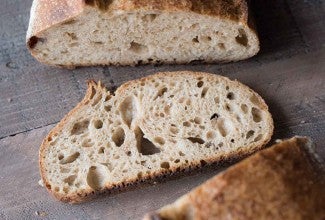


Our eyes are drawn to beautiful loaves of bread with their dramatic “ear” from across the surface or intricate pattern on top. But aesthetics aside, there’s also an important purpose to cutting — or scoring — bread dough before it’s baked.

When we load dough into the oven, the intense heat causes it to rise rapidly by expediting the fermentation process. Through this rapid production of gasses, the dough is forced to spring up and push against the taut surface created during shaping. The weakest spots in the dough's surface — whether intentional or accidental— will give way and crack open.
Most bread bakers score the dough with a blade (or lame) to create a weak point and direct the rapid expansion. Without this step, dough can open in unexpected areas and in a rather chaotic manner. We sometimes desire this type of ragged opening, but if you want the optimal height in a controlled and consistent manner, scoring is the way to go.
Scoring bread dough is yet another part of the baking process where we can each leave our own individual touch on the final baked loaf.
Want that dramatic ear on your bread loaf? Here's everything you need to know about sourdough ears.

Some bakers opt for a single, long slash, whereas others prefer lots of small slashes that together form a beautiful, artistic design. Regardless of the scoring choice, the goal is to guide the dough into rising predictably, consistently, and optimally.
King Arthur has a video on how to slash a baguette, but there are many other approaches, several of which we'll tackle in this article.

In this post, we’ll talk about several dough-scoring implements, the strengths of each, and what type of dough warrants their use. However, as with many things in baking, there are no steadfast rules and each baker should experiment and decide what feels and works best.
For example, some bakers prefer to score with the cutting side of the blade angled away from the body, whereas others prefer to score so the blade cuts inward toward the body. How we score partly depends on how the dough is positioned in front of us: If the dough is horizontal to the body it may be easier for us to cut away, and conversely, if it’s vertical, cutting inward might be a better choice.
As a general rule, it’s best to have a speedy, sure hand when scoring. Hold the blade lightly between your fingers, but in a firmly locked hand, and move with a single, smooth cutting motion. If the blade drags against the dough, don’t fret. Continue with the cut and things will typically smooth out in the bake. If the blade drags excessively, this can be a sign that the dough has most likely proofed for too long and has started to lose structural integrity. Proof the dough for less time, or at a lower temperature, next time.
Warm dough can also be slightly more challenging to score than cold dough proofed in the fridge. The cold dough has a tight, firm surface that holds its shape as the sharp blade cuts through.
Also: Change your scoring blade often! A sharp razor glides through properly fermented dough in a swift, satisfying cut.
In this post, we'll look at bread that was baked using this Fresh Milled Spelt Sourdough Bread recipe. Let's first discuss using a curved blade.
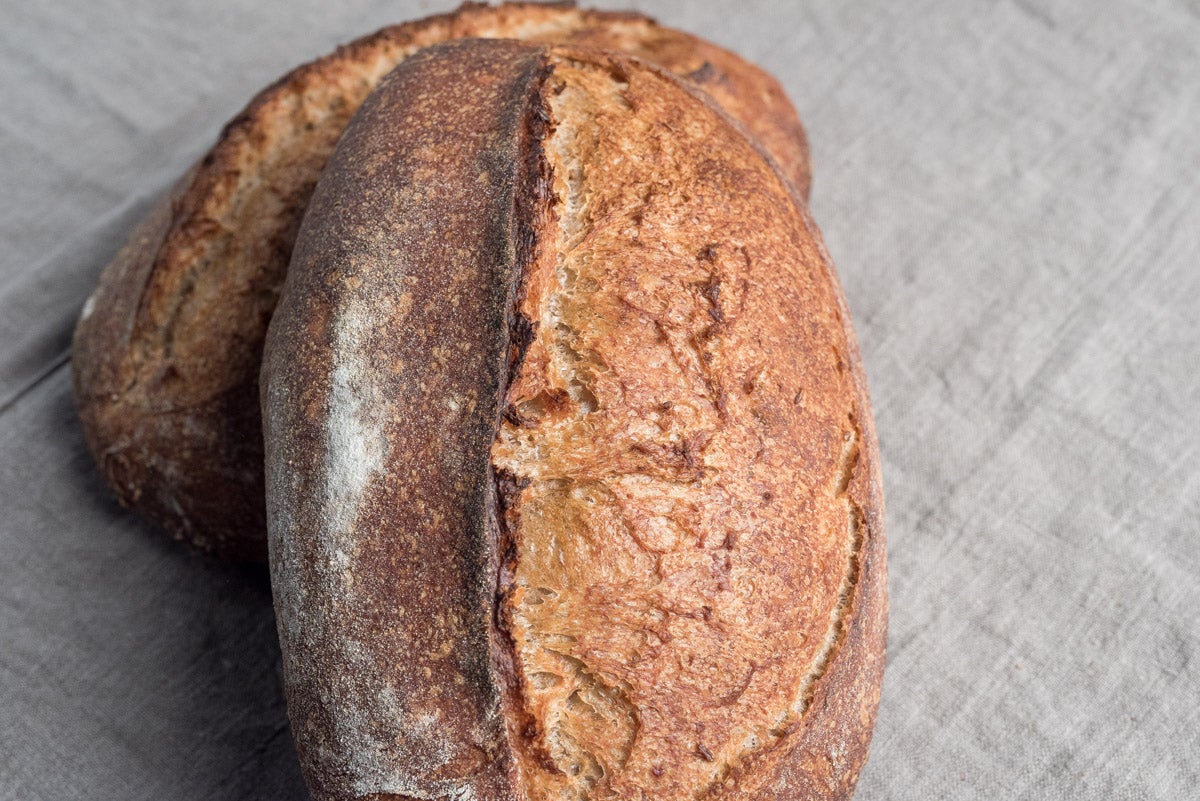
Use a curved blade to score dough when you desire to have a pronounced ear, or raised area of the crust (as seen above). The curve of the blade encourages a flap of dough to form when sliced, and it’s this flap that gets pushed upward and peels back as the dough rises in the oven. We can choose a single, long slash for a dramatic opening or a series of slashes that slightly overlap each other for multiple ears, as with a baguette.
To score using a curved blade, hold the tool securely at about a 30-degree angle to the dough surface. This angle, in concert with the slight upward curve of the blade's cutting edge, will promote the formation of the small flap of dough.
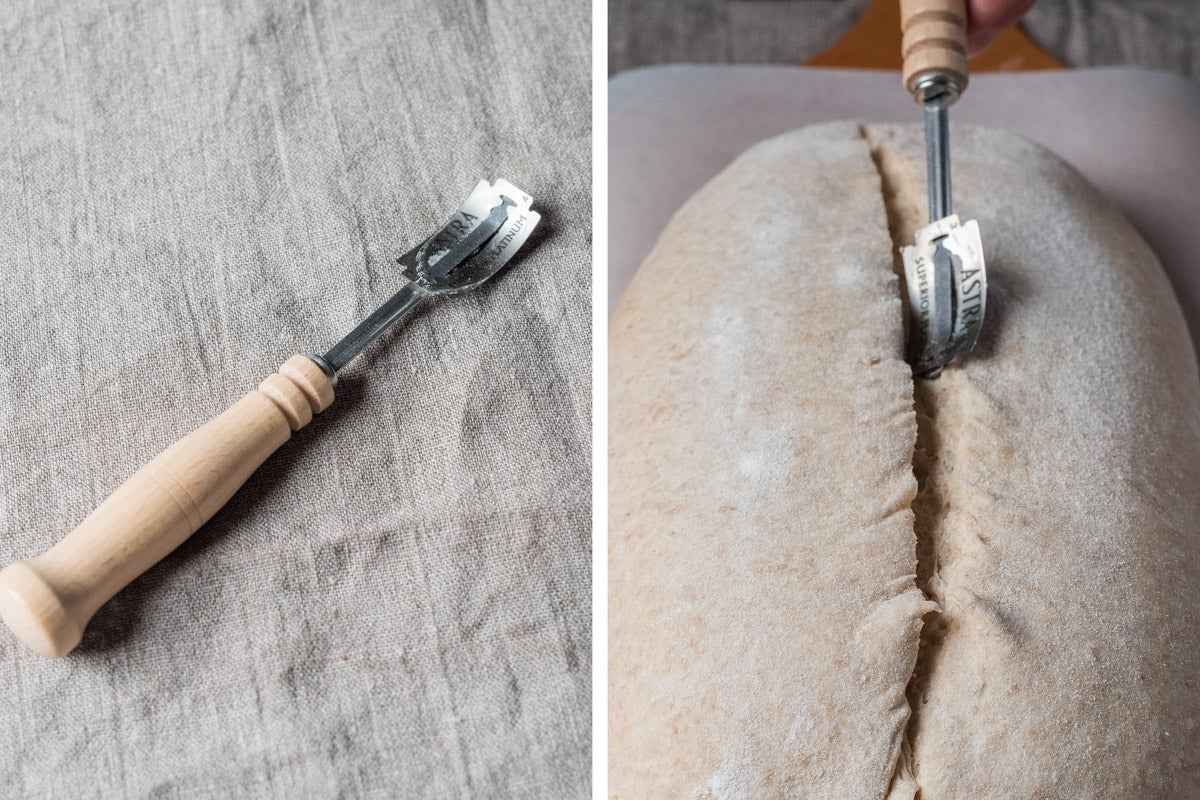
There is no need to press hard and score excessively deep, but the cut does need to be deep enough so the surface of the dough doesn't fuse back together when baking — somewhere between 1/4" and 1/2" deep. Note that if we score the dough too deeply, the final loaf will show signs of caved-in sections as the opening is too large to support the surrounding rising dough.

After making the cut, quickly look into the opening and ensure it goes in and below the taut “skin” formed during shaping. If there are areas where the cut doesn’t quite dig down below the skin, lightly score over this area again with the blade to cut just a bit deeper.
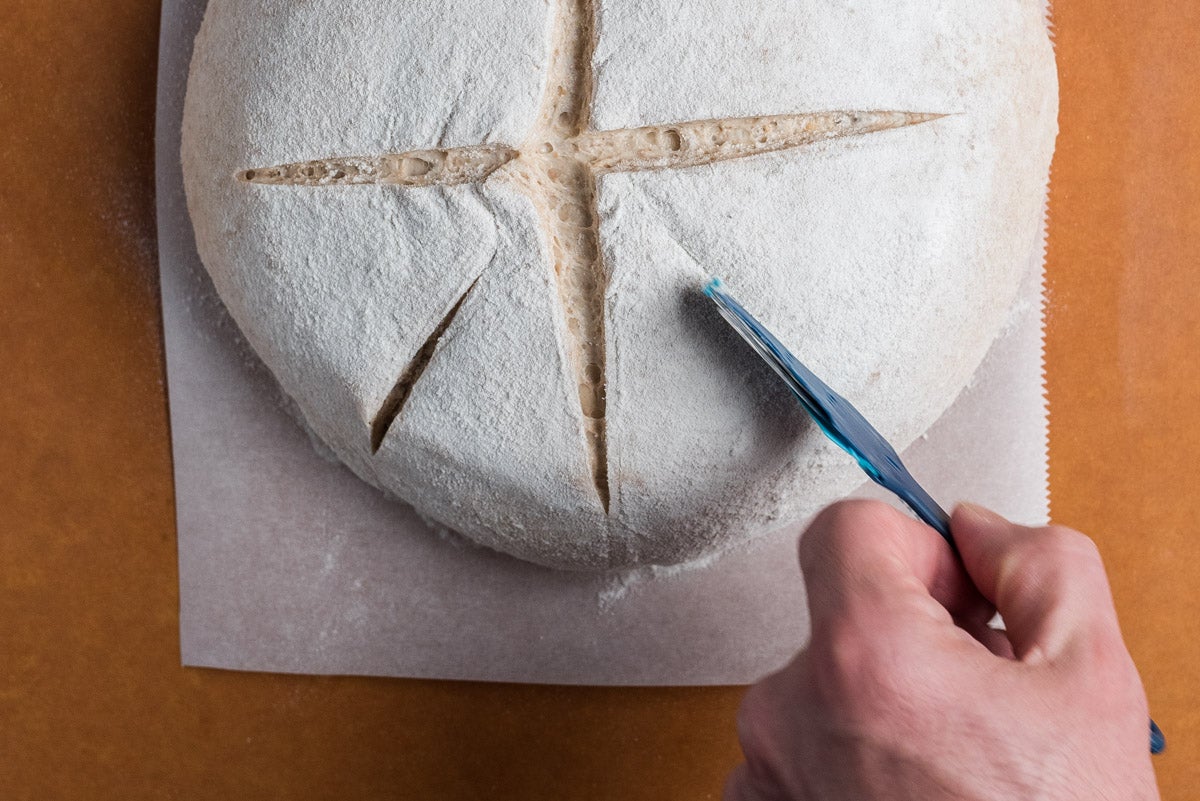
To score using a straight blade, hold the blade perpendicular to the surface of the dough. This cut creates a splayed opening as the dough rises, rather than dough that peels back forming a distinctive ear. Additionally, a straight blade can cleanly create a few, or many, decorative cuts, or even rustic-style boules with a few scattered slashes.
If you wish to make many small, decorative cuts it’s best to cut more shallowly but also more often; in this way, pressure is alleviated evenly across the entire dough surface as it expands in the oven. Conversely, fewer, deeper cuts (closer to 1/2") allow the loaf to open more dramatically in those few spots, rather than evenly in many spots.
To score using a straight blade, hold the blade lightly in the hand and at a 90-degree angle (perpendicular) to the dough. If doing few cuts, score slightly deeper than a curved blade and after doing so you’ll notice the dough relax open and outward.

In the dough shown above, I've used a combination of these techniques by cutting deep for the center "cross" while more shallow for the smaller cuts at the diagonals. This promotes the center to splay open rather dramatically while the diagonal slashes open in a less pronounced way.
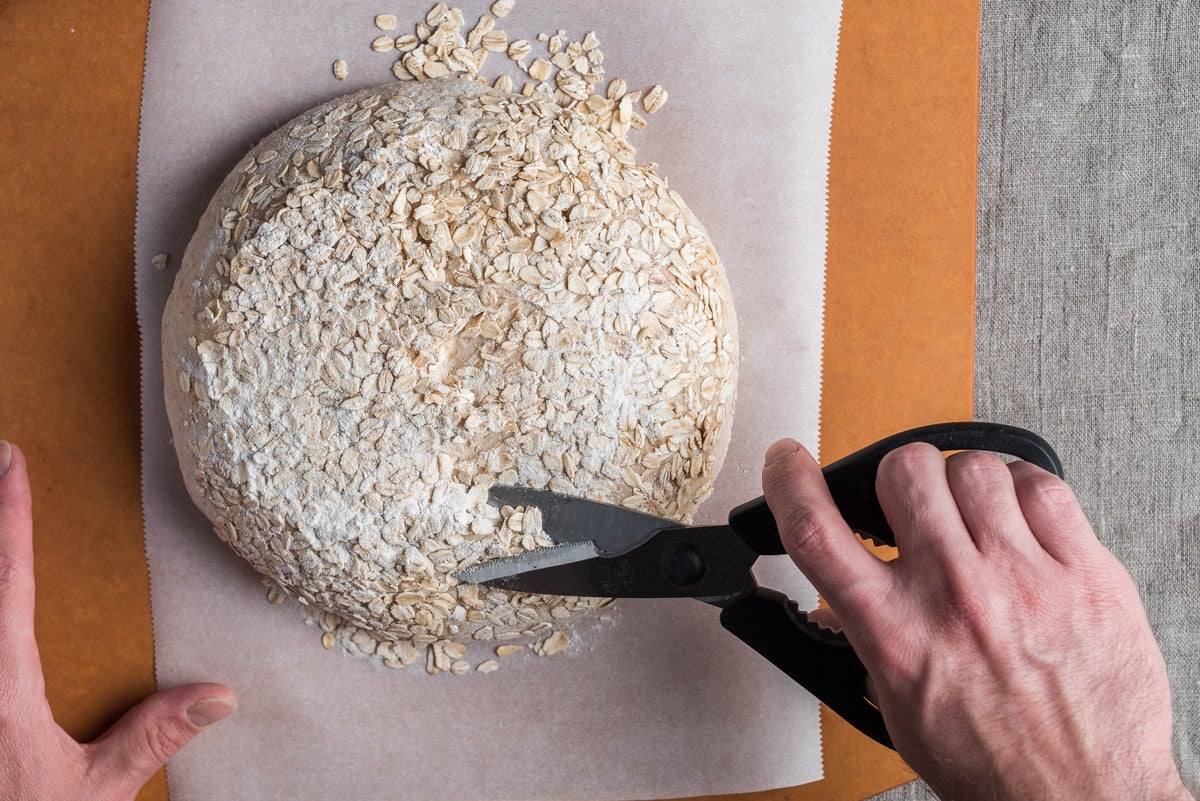
Use common kitchen scissors to score dough that's laden with nuts or coated with grains or seeds. Using a curved or straight blade with these doughs can be difficult as the blade will catch on the additions, causing an uneven and ragged score. Scissors, however, provide clean and precise cuts that open beautifully in the oven, forming a series of ridges for a rustic and unique appearance.
Hold the scissors in your hand with your fingers through the loops, then angle them to about 15 degrees to the dough surface. Perform a series of snips from the top of the dough to the bottom in a single, straight line where each snip starts where the previous one left off.
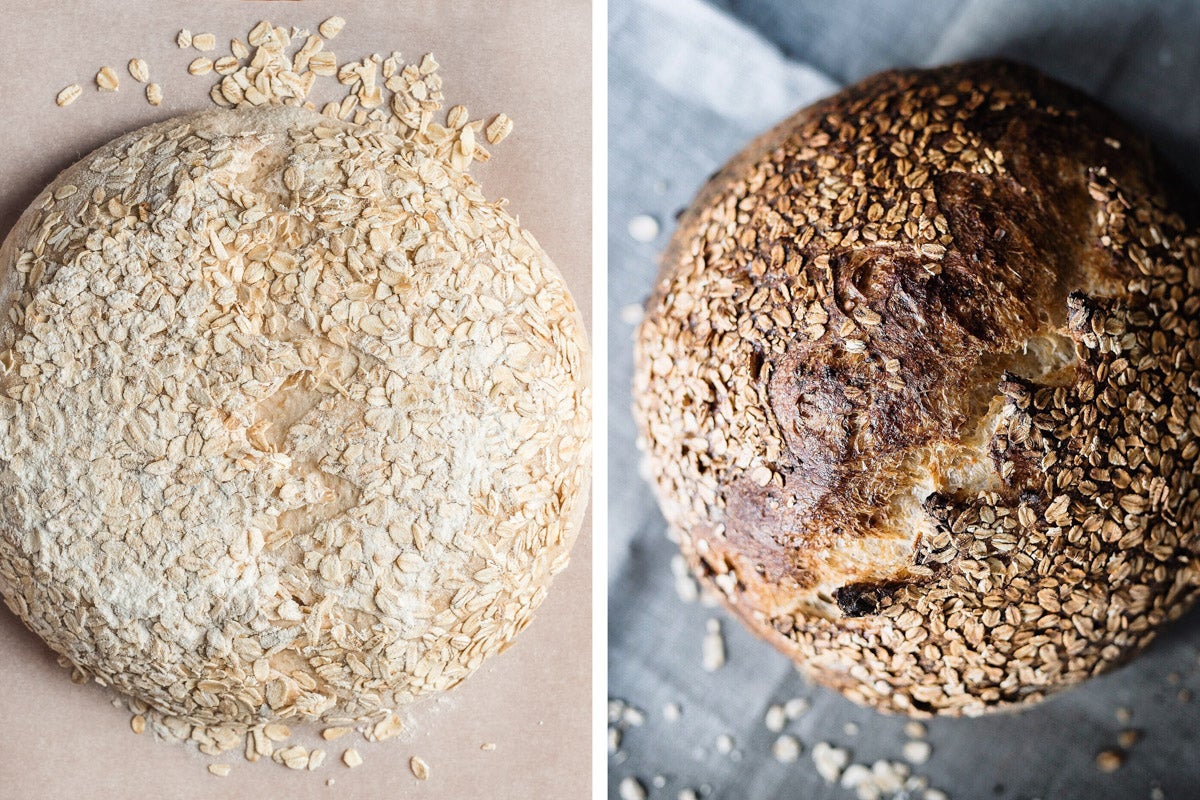
The goal is to create a series of flaps at each cut rather than cutting in deep to the dough. These flaps will pull back when the loaf rises in the oven, creating the unique zig-zag appearance seen above.

There are of course numerous other ways to score dough. But, equipped with these three implements, we can not only effectively score a myriad of dough shapes, but also impart our own unique style and a measure of consistency to each baked loaf.
For ideas and inspiration for scoring designs, check out this post on bread scoring techniques.
Cover photo by Mark Weinberg; food styling by Liz Neily.
